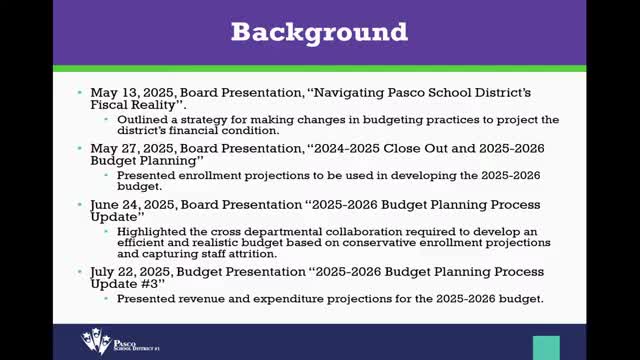Pasco School Board Opens Public Hearing on 2025-2026 Budget Proposals
August 13, 2025 | Pasco School District, School Districts, Washington
This article was created by AI summarizing key points discussed. AI makes mistakes, so for full details and context, please refer to the video of the full meeting. Please report any errors so we can fix them. Report an error »

Pasco School District's Board Meeting on August 12, 2025, highlighted significant financial projections and community concerns regarding the upcoming school year's budget. The board presented a detailed overview of the district's five main funds, including the general fund, capital projects, debt service, associated student body (ASB), and transportation vehicle fund.
The general fund is projected to start with a balance of approximately $16.5 million, with expected revenues and expenditures leading to an ending balance of $12.5 million. This decrease is attributed to efficiency measures and budget cuts implemented in the previous school year. The capital projects fund, which supports construction and improvements, is expected to begin with $27 million and end with around $11.7 million as ongoing projects are completed.
Concerns were raised during the public hearing segment of the meeting, particularly regarding the accuracy of student enrollment projections. Community member Bear Turner expressed skepticism about the district's forecast of stable enrollment at 17,400 students, especially given a significant decline of 1,401 students in the previous two years. He argued that the budget should reflect a proportional decrease in expenses corresponding to declining enrollment.
Turner also criticized the budget for relying on contingency funds to cover unfunded programs, warning that this could lead to a financial crisis. He emphasized the need for transparency in how enrollment trends and costs per student are calculated, as well as the importance of aligning school expenses with actual student numbers.
The board acknowledged these concerns and opened the floor for further public comments, indicating a willingness to engage with community feedback as they finalize the budget for the 2025-2026 school year. The meeting underscored the district's commitment to fiscal responsibility while navigating challenges related to enrollment and funding. As the board prepares to adopt the budget, the implications of these discussions will be closely monitored by both district officials and community stakeholders.
The general fund is projected to start with a balance of approximately $16.5 million, with expected revenues and expenditures leading to an ending balance of $12.5 million. This decrease is attributed to efficiency measures and budget cuts implemented in the previous school year. The capital projects fund, which supports construction and improvements, is expected to begin with $27 million and end with around $11.7 million as ongoing projects are completed.
Concerns were raised during the public hearing segment of the meeting, particularly regarding the accuracy of student enrollment projections. Community member Bear Turner expressed skepticism about the district's forecast of stable enrollment at 17,400 students, especially given a significant decline of 1,401 students in the previous two years. He argued that the budget should reflect a proportional decrease in expenses corresponding to declining enrollment.
Turner also criticized the budget for relying on contingency funds to cover unfunded programs, warning that this could lead to a financial crisis. He emphasized the need for transparency in how enrollment trends and costs per student are calculated, as well as the importance of aligning school expenses with actual student numbers.
The board acknowledged these concerns and opened the floor for further public comments, indicating a willingness to engage with community feedback as they finalize the budget for the 2025-2026 school year. The meeting underscored the district's commitment to fiscal responsibility while navigating challenges related to enrollment and funding. As the board prepares to adopt the budget, the implications of these discussions will be closely monitored by both district officials and community stakeholders.
View full meeting
This article is based on a recent meeting—watch the full video and explore the complete transcript for deeper insights into the discussion.
View full meeting
